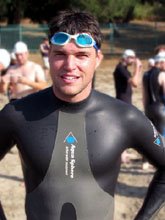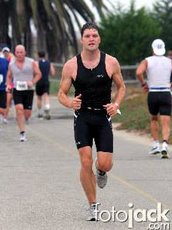So much of my time is spent helping people change the way their bodies LOOK that it's a breath of fresh air to be at an event where all anyone cares about is what your body can DO. Such was the case at the Dina LaVigna Breath of Life Triathlon in Ventura, where I competed this morning. Here's an event where men and women -- in often near-equal numbers -- compete first in swimming gear (wetsuits or swimming suits), then in biking shorts and tank tops, their rumps on proud display for anyone behind them, then, finally, on foot, in whatever soaking, sweat-, snot-, spit-, and sports drink-covered clothing has survived. Despite all the flesh on display, there's a refreshing lack of both self-consciousness and ogling.
To be sure, there are some sleek, lithe women and ripped, muscular guys at these events. But one admires them not simply because they look good, but because their bodies are trained for a purpose. Thighs are strong and toned not because of lunges around the block but because of hours of bike sprints, hill runs, and high-intensity sprint work. Upper bodies are muscular not because of multiple sets of Swiss Ball bent-over cable crossovers but because of thrice-weekly sessions of 50-, 100-, 200-, and 400- meter freestyle repeats. And all that work is primarily towards the goal of getting faster, and looking better is a happy side effect.
I don't want to moralize here, or criticize anyone's reasons for exercising. As I've said previously, if the idea of looking like Angelina Jolie gets you to push your limits five days a week, great. In our visually-oriented culture, pecs and abs and glutes have currency. But speaking as someone who resisted participating in sports until I was way past my prime, I have to say that the last few seasons of competing as a triathlete have been a real eye opener.
To be sure, in Ventura this morning there were some impressive-looking physiques. There were also some decidedly average ones. The funny thing is that it didn't seem to make much difference: I flew past a couple of guys who were built like Adonises; karmically, an equal number of chubbyish or beanpoley guys left me choking on their dust as well. And it did me little good, as I mulled over my final standings on the preliminary results board, to think "Well, I LOOK stronger than that guy," when 'that guy' casually flayed my bike split time by about five minutes." As in boxing, where a tough but skinny scrapper can often take apart the Hercules standing across the ring through sheer technique, guts, and persistence, preen-worthy muscles don't mean much when you're trading punches or trying to get your badass, hypertrophied self across a finish line in a respectable time frame. A strong heart -- both the literal and figurative kind -- will beat out a cover model body every day of the week.
It's worth remembering that in nature, form runs a distant second to function. Sure, there is evolutionary value in looking good: a healthy, strong looking marmoset stands a better chance of attracting a mate than his listless-looking brother. And maybe an alpha-male silverback's enormous size can deter potential usurpers from even trying to knock off the king (clearly these cowed gorillas aren't students of the sweet science). But in general the body looks better because it can function better, not the other way around. Basic Darwinism tells us that we're here to pass on our genes, and we're more likely to be able to do that if we can run from the saber-toothed tiger and bash him over the head with a rock than we are if we look good doing a front-lat spread. Like nature, sports favor the development of function over form.
Anyway, I've written about this before, so I won't chew my cabbage twice, but for these reasons, competing in something is definitely worth looking into for everyone. Seriously, everyone -- particularly those of us whose exercise routine usually consists of classes that promise to "tone" and "lengthen" the muscles (two almost meaningless terms, incidentally), or of workouts consisting largely of benching, curling, and crunching.
A triathlon can be a surprisingly manageable place to start: there are sprint distance events that take under an hour to complete (comfortably) -- the distances I did in Ventura were 1/4 mile swimming, 12.7 miles biking, and 3.1 miles running -- all well within the reach of the average exerciser (pro triathlete Eric Harr has a book called Triathlon Training in Four Hours a Week that promises to get you across the finish line in six weeks. The book's title is an exaggeration of his actual guidelines, but his book shows that it is possible to finish a triathlon on minimal training.)
But if endurance sports aren't your thing, that's cool. But most of us can find something to compete in. Active.com is a great place to start; you can scroll through a pretty darn comprehensive list of sports in your area and see what appeals. Chances are there will be a division for amateurs, or over-50s, or one-eyed people under 4 feet, and even if there isn't, so what? A woman with ONE LEG did the triathlon yesterday, and in case you haven't seen it, these guys are multiple Ironman finishers, so what's your excuse?
Here endeth the soapbox.
For anyone who's interested, I managed to pull off a fairly respectable time in the race. I hadn't swum in the ocean seriously in over a year, and I spent most of the quick 1/4 mile in the water bemused at how unlike pool swimming such an event is. With dozens of nervous guys to your left, right, fore and aft, elbows and feet flying in dangerous proximity to your eyes and face, murky water all around you, waves of varying sizes swelling beneath, salt water sloshing down your throat, a short ocean swim like the one at Ventura bears about as much resemblance to a pool swim as actual warfare does to a game of Risk. I'd forgotten just how ungraceful and comical the swim portion of most triathlons can be, but I've come to appreciate that no matter how poised and ready the competitors are, no matter how much precision and planning they've brought to the event, every triathlon starts out in an awkward melange of arms, legs, churning water, and hyped-up energy, reminding us from the outset what eager, stumbling, flailing fools we can be. So the swim was short, chaotic and funny.
The bike portion was the surprise: I was expecting to average 20 miles per hour or less, but was surprised to pull into the bike-run transition having averaged 21.4 miles per hour over the 12.7 mile course, shaving a couple of minutes off my predicted bike-split time. I traded passes several times with a determined-looking guy on a very fancy-looking bike; this seems to happen a lot -- there's someone in the lineup who's just about as fast as you are, and without saying a word, you kind of pace one another.
I always try to relax a little at the top of the run. "Jello legs" are common at the run start, because your muscles have been primed for cycling and thus the hamstrings haven't been working at all while the quads and glutes are on overdrive. So I usually try to plaster a grin on my face and take in my surroundings a little, which along the beach in Ventura are lovely. Passing the mile mark I opened it up a little, finishing the 5K in around 22 minutes, just about the time I expected.
Preliminary results had me finishing in about 1:08, good for 5th place among the 35-39 age groupers, which is much further up the food chain than I expected -- mostly, I think, due to my totally unexpected spurt of energy on the bike. Final results aren't up online yet, meaning all this could change, but watch this space in case you're perversely interested.
An exhilarating weekend, all told. And a great event.
Subscribe to:
Post Comments (Atom)




2 comments:
Wow, that Ironman Dad and son video killed me...
And after the pool clobbering clip... y'all must be masochists to do these Triathlons! LOL
u r cute :D
Post a Comment